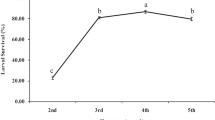Abstract
The seasonal variation in parasitism on Pyrilla perpusilla Walker (Lophopidae: Homoptera) in situ by parasitoids were examined at fortnightly interval, from April to December 2004 (Plant crop) and 2005 (Ratoon crop) in sugarcane ecosystem. These fields were kept free from insecticidal applications. During, 2004 there was no parasitization in the month of April while 3.7± 0.2 per cent nymphs were parasitized in May first fortnight. With the increase in Pyrilla population, rise in parasitization by Epiricania melanoleuca (Epipyropidae: Lepidoptera) started and reached its peak 80.5± 4.9 per cent on nymphs in November second fortnight. Adult parasitization (6.2± 0.5%) was noticed in May first fortnight and touched its peak at 77.0± 5.1 per cent in November second fortnight. While during 2005 parasitization were observed at 82.3± 4.8 per cent on nymphs and 75.0± 3.9 per cent on adults in November second fortnight. The range of parasitization by E. melanoleuca on nymphs+ adults was 5.0± 0.4 to 78.8± 5.0 per cent and 4.8± 0.7 to 78.7± 4.4 per cent during 2004 and 2005, respectively. Significant negative correlation with maximum (r=−0.825) and minimum (r=−0.800) temperature and non significant positive correlation with Relative humidity (r=0.352) and Rain fall (r=0.242). Per cent parasitism by egg parasitoids (combined) viz., Parachrysocharis javensis, Cheiloneurus pyrillae and Ooencyrtus pyrillae varies from 23.8± 2.9 to 83.0± 5.8 per cent from the month of July to December based on egg mass but based on individual eggs it was 9.6±2.1 to 78.2±5.2 per cent. Highest parasitization was in the month of December. No hyper parasitoid recorded on egg of E. melanoleuca. The hyper parasitoid Ecthrodryinus sp. (0.7±0.2 to 2.3± 0.2 per cent) and Fusarium sp. (0.4± 0.1 to 6.8± 2.3 per cent) recorded on pupae of E. melanoleuca from September to November.
Similar content being viewed by others
References
Anonymous (2007) Outbreak of Pyrilla. IISR Newsletter 14:2.
Brar RS (1978) Role of natural enemies in the population dynamics of Pyrilla perpusilla Walker. Ph.D. Thesis, PAU, Ludhiana, Punjab. pp 83.
Fletcher (1939) A new Epipyrops from India (Lepidoptera: Epipyropidae) Bull Entomological Res 30: 3.
Hugar PS, Rachappa V, Rajendra H (2002) Population dynamics of sugarcane leaf hopper, Pyrilla perpusilla Walker and its natural enemies in Northern Karnataka. In: Resources management in plant protection during twenty first centuries, Hyderabad, 14–15-November, 2: 26–29.
Jadhav R B, Varma A (1988) Record of a hyper parasitoid and two predators on Epiricania melanoleuca Fletcher in Maharashtra. J Biol Control 2: 33–34.
Kalra A N(1973) Pyrilla a menace to sugarcane and sugar industry. Indian Sugar 23:737–739.
Krampl F, Dlabola J (1983) A new genus and species of Epipyropid moth from Iran, ecto parasitic on a new Mesophantia species, with a revision of the host genes (Lepidoptera, Epipyropidae; Homoptera, Flatidae) Acta Entomologica Bohemoslov 80: 451–472.
Kumarasinghe N C, Wratten S D (1996) The sugarcane lophopid Pyrilla perpusilla (Homoptera: Lophopidae): a review of its ecology, pest status and control. Bull Entomological Res 86:485–498.
Madan Y P, Chaudhary J P (1995) Extent of natural parasitization of Pyrilla perpusilla Walker and seasonal abundance of Epiricania melanoleuca Fletcher. Indian Sugar 45: 683–688.
Pandya H V (1997) Population status of sugarcane Pyrilla (Pyrilla perpusilla Walker) and its ecto-parasite (Epiricania melanoleuca Fletcher) in Gujarat. Coop Sugar 28: 899–902.
Pandya H V (1998) Hyper parasitism in Epiricania melanoleuca, an ecto — parasite of sugarcane Pyrilla in Gujarat state. Coop Sugar 30: 109–110.
Patel D R, Patel M B, Patel C sB (1993) Population dynamics of sugarcane leaf hopper (Pyrilla perpusilla Walker) and its ecto-parasite (Epiricania melanoleuca Fletcher) in relation to climate. GAU Res J 19: 56–63.
Pawar A D, Misra M P, Singh J (2002) Role of Epiricania melanoleuca Fletcher in Biological control of sugarcane Pyrilla, Pyrilla perpusilla Walker outbreak in 1999 in western Uttar pradesh. J Biol Control 16:71–76.
Rajak D C, Singh R P, Tripathi R A, Kumar S (2006) Studies on biology of Epiricania melanoleuca Fletcher a potent parasitoid for management of Pyrilla perpusilla Walker in Sugarcane. Indian J Sug cane Tech 21:49–53.
Rajak D C (2007) Colonization and redistribution of Epiricania mealanoleuca Fletcher against Pyrilla perpusilla Walker. Ann Pl Protec Sci 15:83–86.
Rajak D C, Varma A (2001) Natural enemy complex of insect-pests of sugarcane in the southern zone of Andhra Pradesh. Indian J Sugarcane Tech 6:114–116.
Rajak R L, Pawar A D, Misra M P, Prasad J, Verma A, Singh G P (1987) Sugarcane Pyrilla epidemic 1985-a case study. Pl Protec Bull 39: 1–9.
Singh J, Singh S P, Brar K S, Singh M (2000) Natural control of sugarcane Pyrilla in Morinda (Ropar) mill area of Punjab. Insect Environ, 6:128–129.
Tewari N K and Tanwar R K (2001) Biocontrol agents of sugarcane pests and their bioecology, mass production and field application. (Biocontrol potential and its exploration in sustainable agriculture vol.2. insect pests-(eds. R. K. Upadhyay, K. G. Mukerji and B. P. Chamola), pp 189–213.
Yadav R P (1983) Bionomics, effectiveness and basic requirements for mass multiplication of common egg parasitoids of Pyrilla perpusilla Walker. Ph. D. Thesis, HAU, Hisar, pp 84.
Author information
Authors and Affiliations
Corresponding author
Rights and permissions
About this article
Cite this article
Rajak, D.C., Singh, R.P., Prasad, K. et al. Parasitism and hyper parasitism on Pyrilla Perpusilla Walker in sugarcane ecosystem. Sugar Tech 10, 150–153 (2008). https://doi.org/10.1007/s12355-008-0026-9
Received:
Revised:
Accepted:
Published:
Issue Date:
DOI: https://doi.org/10.1007/s12355-008-0026-9




